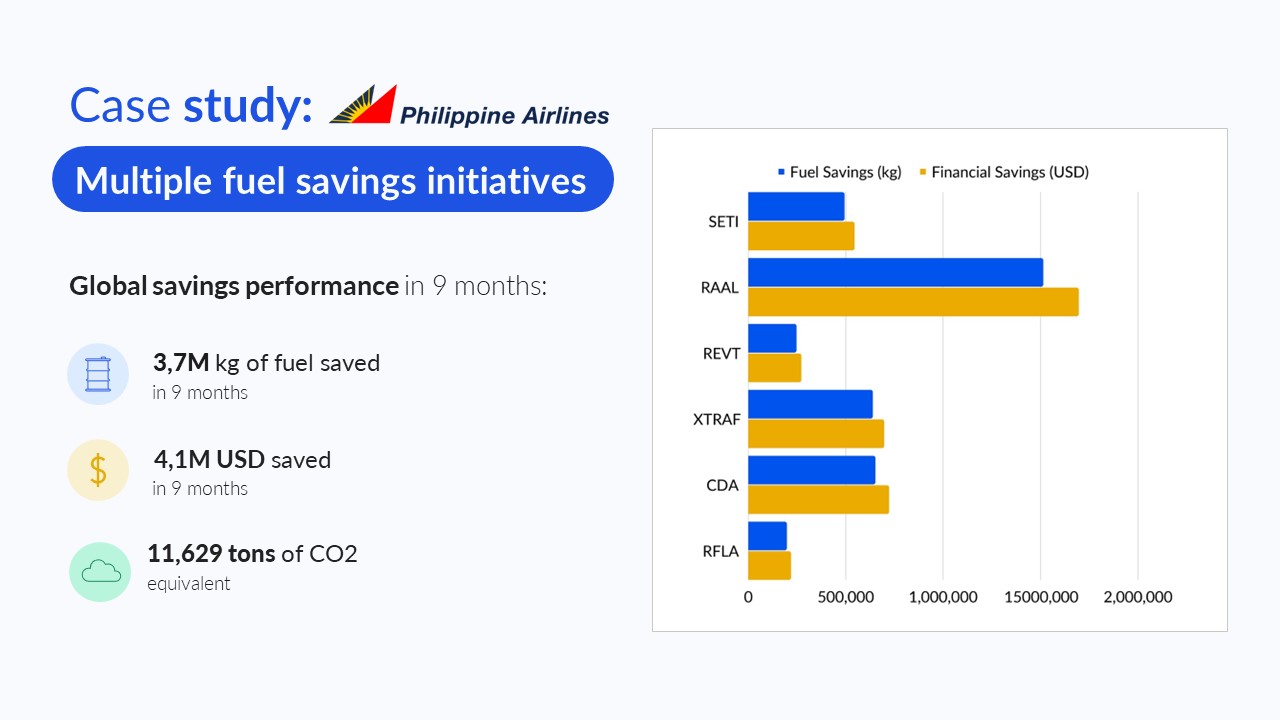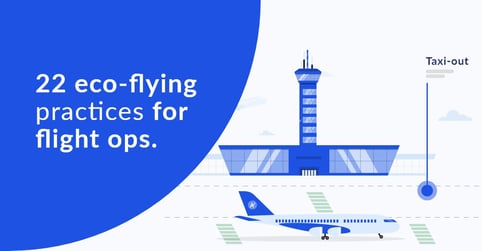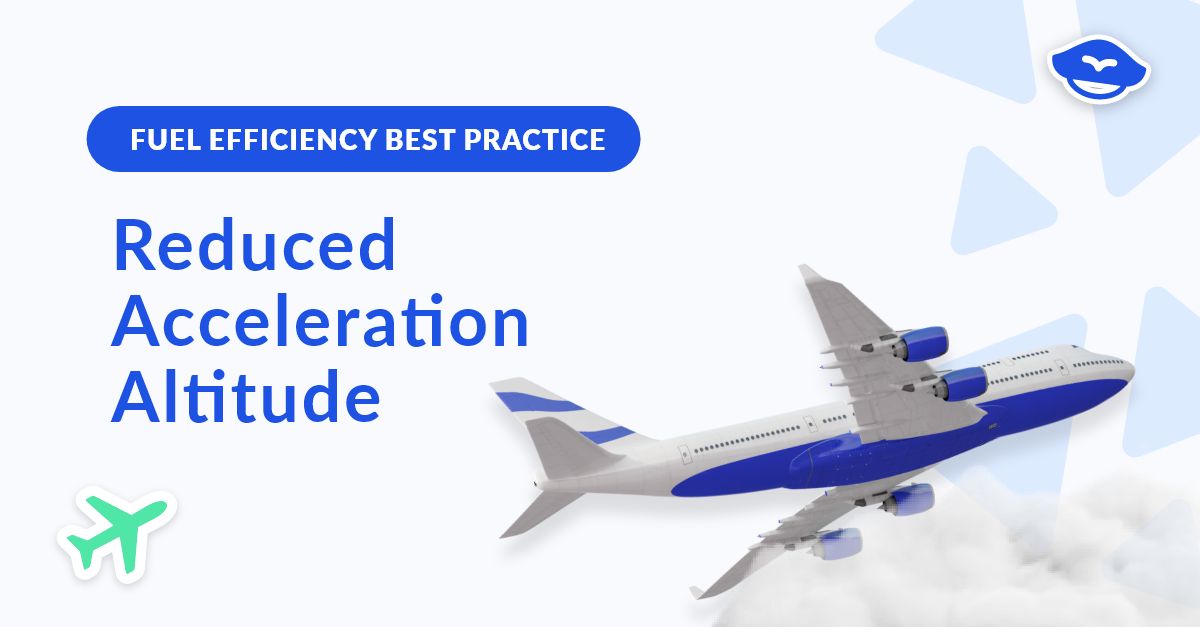Why lowering aircraft acceleration altitude improves fuel efficiency?
In commercial aviation's highly competitive world, optimizing fuel efficiency is a crucial financial and environmental strategy for airlines. A frequently used innovative fuel-saving practice is Reduced Acceleration Altitude (RAAL). This eco-flying technique applied during the climb phase of a flight, can help airlines boost their fuel programs, providing that noise abatement procedures allow it.
In this article, we'll provide all the details on RAAL, why you should use it, and how to overcome challenges to implement it.
|
Summary |
What is Reduced Acceleration Altitude?
Reduced Acceleration Altitude involves starting the airplane's acceleration sooner, at a lower altitude than normal operations. Usually, planes ascend to a specific altitude before they start to retract flaps/slats and speed up to a faster, more efficient flying speed. When the acceleration starts at this lower height, the plane can switch to the efficient flight mode more quickly and reduce drag. This means it faces less resistance from the air, making it more efficient. In most cases, the altitude is reduced from 3000ft to 800ft. For lighter aircraft, it can go down to 400ft.
.png?width=650&height=371&name=Reduce%20Acceleration%20Altitude%20(NADP%201%20vs%20NADP%202).png) Figure 1: Reduce Acceleration Altitude (NADP 1 vs NADP 2)
Figure 1: Reduce Acceleration Altitude (NADP 1 vs NADP 2)
-
In red, the usual NADP1 procedure, where the aircraft accelerates at 3000ft
-
In green, the perfect application of Reduced Acceleration Altitude, where the aircraft accelerates at 800ft. It is equivalent to NADP2 procedure.
Why apply a Reduced Acceleration Altitude?
Implementing RAAL offers several benefits:
-
Fuel Efficiency: Reducing acceleration height can boost fuel efficiency based on the ability to adopt a clean configuration earlier in the flight. This involves retracting the aircraft's flaps and slats sooner than usual, reducing drag. By minimizing resistance from the air at an earlier phase, airplanes can achieve greater fuel efficiency, making for a smoother and more economical journey.
In 2024, the SkyBreathe® airline community saved more than 102,268 tons of fuel by applying the Reduced Acceleration Altitude best practice. That represents more than 322.145 tons of CO2 emissions prevented from going into the atmosphere.
-
Reduced Emissions: With improved fuel efficiency comes a reduction in carbon emissions.
By embracing eco-flying techniques such as RAAL, the industry shows its commitment to innovation and progress toward achieving net zero CO2 emissions by 2050.
The chart below shows what are the typical fuel saved, depending on the aircraft type:

Figure 2: Typical fuel saved depending on the aircraft type by reducing acceleration height
The benefits than can be expected are about 16 kg per flight for a TurboProp up to 200 kg for a Long Range aircraft, which is non-negligible!
Related content >>> Fly Net-Zero 2050: how airlines use data to improve fuel efficiency?
The challenges of Reduced Acceleration Altitude
While the benefits are clear, integrating the RAAL eco-flying technique into standard aviation procedures requires overcoming various challenges, from technological adaptations to operational considerations.
Coordinating with Air Traffic Management for seamless RAAL implementation
Working together with Air Traffic Control (ATC) is crucial, as this practice may affect traffic flow and separation. Lowering the acceleration height can potentially affect the sequencing of aircraft in the airspace and may require adjustments in air traffic flow management. It's essential to ensure that reduced acceleration procedures are integrated seamlessly into existing air traffic management systems to maintain safe and efficient operations.
Navigating noise abatement regulations for RAAL compliance
Understanding and adhering to local noise abatement procedures is essential and can vary across different regions and airports. Pilots and airlines must be aware of specific noise abatement procedures at each airport and comply with them to minimize the impact of aircraft noise on surrounding communities.
RAAL is only applicable when noise abatement procedures (specified on the airport’s AIP) allow accelerating below 3000ft.
There are two noise abatement departure procedures, NADP1 and NADP2, used by aircraft during takeoff to minimize noise pollution. The choice between these procedures is specific to each airport. In the below figures, you will see what is the difference between NADP1 and NADP2.

Noise Abatement Departure Procedure 1
NADP1 focuses on noise reduction near airports, involving a steep climb and later acceleration. Many large airports, especially in Europe, prevent accelerating before 3,000 feet to mitigate the impact of aircraft noise on nearby communities.

Noise Abatement Departure Procedure 2
NADP2 allows for earlier acceleration, reaching optimal performance sooner than with NADP1 (acceleration from 800ft). RAAL fuel efficient procedure matches with NADP2.
Boeing claims that the fuel saved by flying an NADP2 procedure vs an NADP1 procedure is 67 kg on a Boeing 737-800 with winglets and 197 kg on a Boeing 777-200ER.
Aircraft performance variability: How RAAL benefits differ by aircraft type
Not all aircraft types may experience the same level of benefit from RAAL. Factors such as aircraft size, engine type, and weight can influence the effectiveness of reduced acceleration procedures. Some aircraft may require longer distances to reach optimal climb performance, while others may benefit more from reduced acceleration height. Airlines need to consider the performance characteristics of their fleet and assess the feasibility and effectiveness of reduced acceleration altitude procedures on a case-by-case basis.
Addressing these challenges requires collaboration and cooperation among stakeholders to work towards implementing the RAAL procedure more effectively. Airlines can leverage advanced fuel efficiency tools and technologies to integrate reduced acceleration height procedures into their flight management systems. This strategy can maximize environmental benefits while enhancing operational and cost-effectiveness.
How to implement RAAL in your fuel program
For airlines considering the adoption of RAAL, there are two key points to consider carefully. By addressing these points thoughtfully, fuel teams can make informed decisions regarding the implementation of RAAL and contribute to their airline's sustainability goals.
1. Implementing Reduced Acceleration Altitude in flight operations
Pilots need thorough training to implement this strategy effectively, including recognizing the optimal scenarios for utilizing Reduced Acceleration Altitude. Training, coupled with the usage of analytical tools, can fortify the Flight Operations team's capabilities to monitor, measure, and implement this practice with utmost effectiveness.
Take the example of SkyBreathe® 360° eco-flying solution. By harnessing aircraft data, the solution provides precise metrics for the fuel team to assess the impact of RAAL in terms of fuel savings, emissions reduction, and return on investment (ROI). The solution uses AI to determine which NADP constraint applies to which airport, so at which altitude pilots could begin to accelerate.
Accessing advanced analytics allows airline teams to make well-informed and efficient decisions about their operational strategies.
Related content >>> [CASE STUDY] Fuel efficiency at Philippine Airlines

Figure 3. RAAL best practice implemented by Philippine Airlines to save fuel.
Source: [CASE STUDY] Fuel efficiency at Philippine Airlines
2. Enhancing pilot engagement
Ensuring pilot commitment is essential since they are responsible for applying this fuel efficiency technique during the flight. Here are a few tips to help you engage your pilots:
-
Giving pilots access to relevant data can help you address any doubts about RAAL's safety and effectiveness, and encourage adoption.
-
Having clear company SOPs for RAAL assures pilots that your airline has thoroughly evaluated the procedure and offers official guidance for its application, instilling confidence in pilots.
-
Introducing RAAL in pilot training can foster a fuel-saving mindset, ensuring proficiency and practical application.
Go the extra mile >>> 5 tips for engaging pilots applying Reduced Acceleration Altitude
Here’s an example of how a pilot engagement app can boost RAAL application rate within an airline:

Have you considered providing pilots with access to their performance data?
By highlighting the impact of their actions and providing them with personalized feedback, you can help them develop their eco-flying skills and boost their motivation to apply fuel preservation procedures. Mobile apps such as SkyBreathe® MyFuelCoach are very effective in engaging pilots and improving their adherence to the airline’s fuel efficiency program.
To sum up
Reduced Acceleration Altitude is an effective operational strategy for airlines seeking to reduce fuel consumption and emissions. The industry can make notable strides toward sustainable aviation thanks to this eco-flying practice by combining operational strategies, cutting-edge technology, and active pilot involvement.
Originally published: Mar 19, 2024
Last update: Mar 25, 2025
WANT TO LEARN MORE?
Discover more fuel-saving practices to apply during a flight >> Read the full article!



